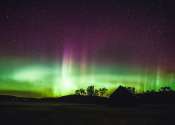NASA mission to study mysteries in the origin of solar radio waves
NASA's CubeSat Radio Interferometry Experiment, or CURIE, is scheduled to launch July 9, 2024, to investigate the unresolved origins of radio waves coming from the sun.

NASA's CubeSat Radio Interferometry Experiment, or CURIE, is scheduled to launch July 9, 2024, to investigate the unresolved origins of radio waves coming from the sun.
Astronomy
Jul 8, 2024
0
48

NASA's near-Earth-object-hunting mission NEOWISE is nearing its conclusion. But its work will carry on with NASA's next-generation infrared mission: NEO Surveyor.
Astronomy
Jul 2, 2024
0
19

When a solar flare leaps out from around the sun, a small fleet of scientific instruments designed and built at the University of Colorado Boulder form a first line of defense—spotting these massive eruptions before any ...
Astronomy
Jun 21, 2024
0
33

NASA has set its sights on the moon, aiming to send astronauts back to the lunar surface by 2026 and establish a long-term presence there by the 2030s. But the moon isn't exactly a habitable place for people.
Space Exploration
Jun 13, 2024
0
23

In addition to producing auroras, a recent extreme storm provided more detail on how much radiation future astronauts could encounter on the Red Planet.
Space Exploration
Jun 10, 2024
0
45

In May, powerful solar storms delivered stunning auroras to latitudes that rarely experience them. Light shows were seen as far south as Florida and Texas, while more northerly areas of the United States were treated to spectacular ...
Astronomy
Jun 4, 2024
0
28

The sun emitted a strong solar flare, peaking at 10:37 a.m. ET on May 29, 2024. NASA's Solar Dynamics Observatory, which watches the sun constantly, captured an image of the event.
Astronomy
May 30, 2024
0
128

For the first time, scientists have observed plasma waves from a solar flare focused by a coronal hole, akin to the focusing of sound waves responsible for the Rotunda effect in architecture or the focusing of light by a ...

The powerful solar storm driving the aurora borealis over global skies last weekend was also triggering the movement of compasses deep in the ocean, as revealed in new scientific findings shared today by Ocean Networks Canada ...
Planetary Sciences
May 16, 2024
0
40

The sun produced its biggest flare in nearly two decades Tuesday, just days after severe solar storms pummeled Earth and created dazzling northern lights in unaccustomed places.
Planetary Sciences
May 15, 2024
0
1444
A solar flare is a big explosion in the Sun's atmosphere that can release as much as 6 × 1025 joules of energy. The term is also used to refer to similar phenomena in other stars, where the more accurate term stellar flare applies.
Solar flares affect all layers of the solar atmosphere (photosphere, corona, and chromosphere), heating plasma to tens of millions of kelvins and accelerating electrons, protons, and heavier ions to near the speed of light. They produce radiation across the electromagnetic spectrum at all wavelengths, from radio waves to gamma rays. Most flares occur in active regions around sunspots, where intense magnetic fields penetrate the photosphere to link the corona to the solar interior. Flares are powered by the sudden (timescales of minutes to tens of minutes) release of magnetic energy stored in the corona. If a solar flare is exceptionally powerful, it can cause coronal mass ejections.
X-rays and UV radiation emitted by solar flares can affect Earth's ionosphere and disrupt long-range radio communications. Direct radio emission at decimetric wavelengths may disturb operation of radars and other devices operating at these frequencies.
Solar flares were first observed on the Sun by Richard Christopher Carrington and independently by Richard Hodgson in 1859 as localized visible brightenings of small areas within a sunspot group. Stellar flares have also been observed on a variety of other stars.
The frequency of occurrence of solar flares varies, from several per day when the Sun is particularly "active" to less than one each week when the Sun is "quiet". Large flares are less frequent than smaller ones. Solar activity varies with an 11-year cycle (the solar cycle). At the peak of the cycle there are typically more sunspots on the Sun, and hence more solar flares.
This text uses material from Wikipedia, licensed under CC BY-SA